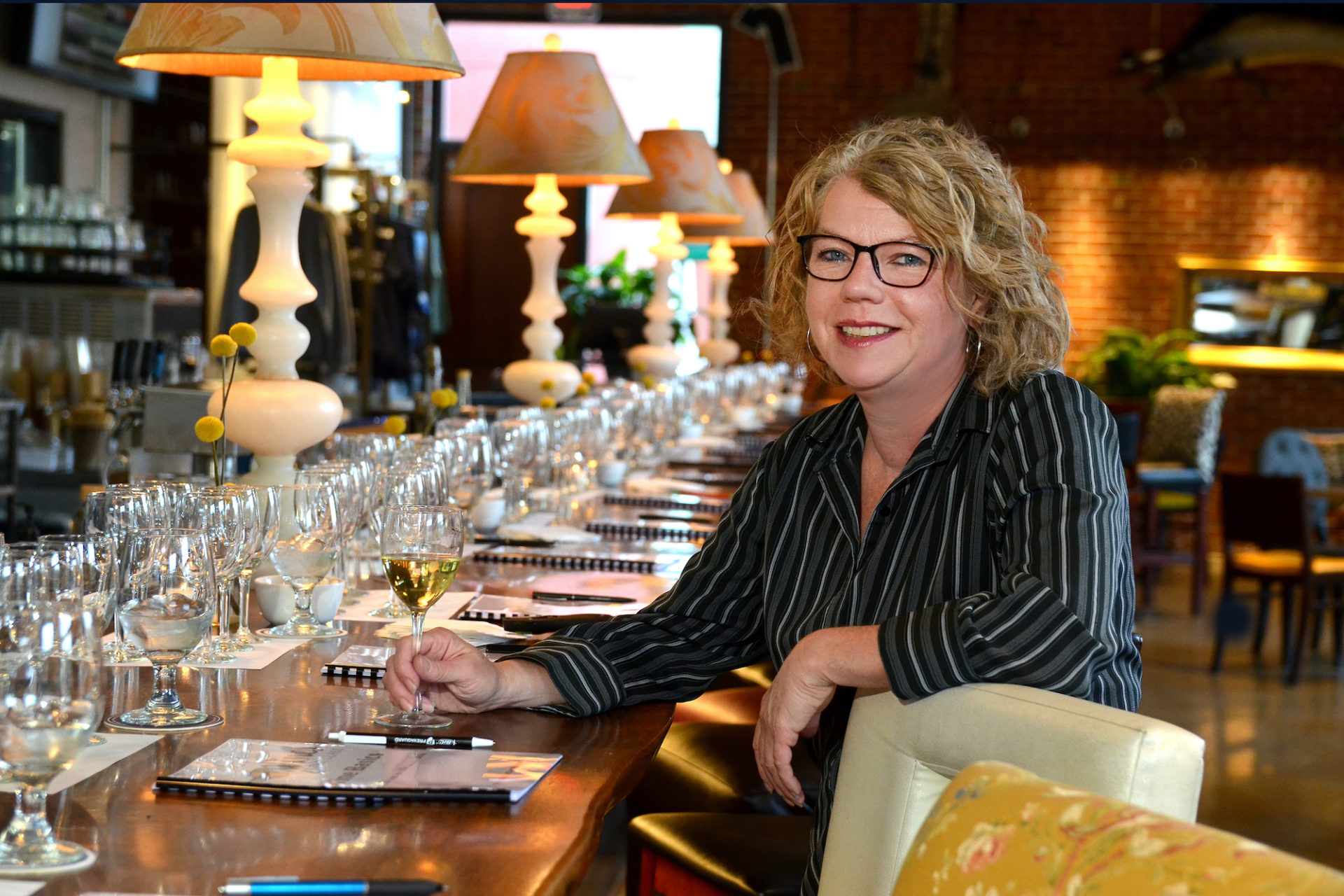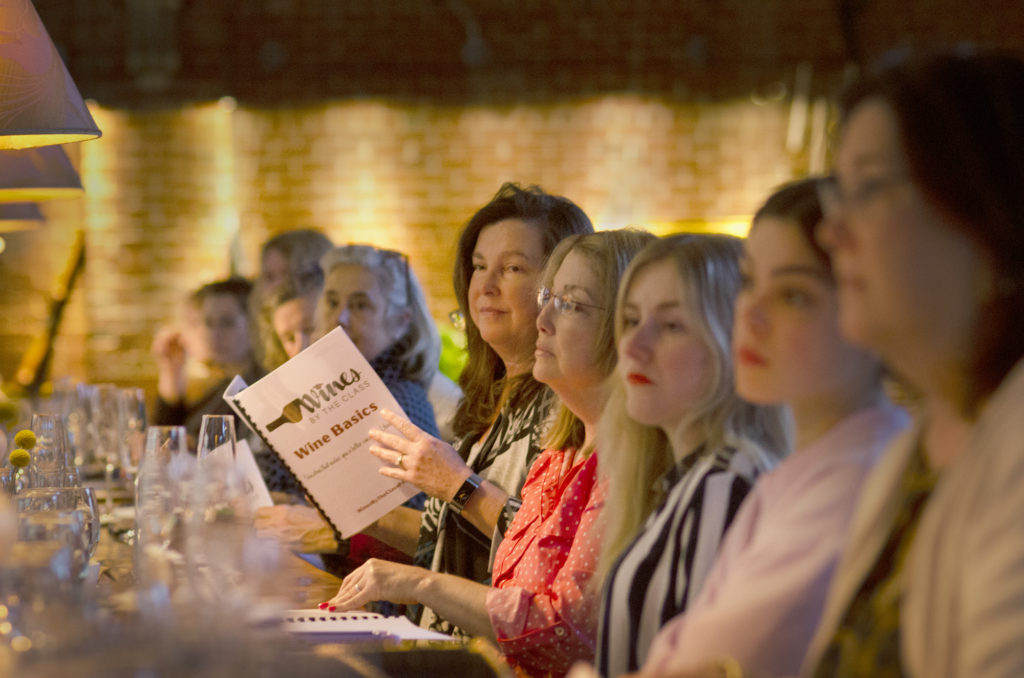
Lucy Rogers shares her extensive knowledge of wines through Wines by the Class. (Photo by Chuck Fong)

Lucy Rogers shares her extensive knowledge of wines through Wines by the Class. (Photo by Chuck Fong)
There is something romantic about opening and sharing a bottle of wine. Twisting the corkscrew into the cork and then slowly pulling it out until I hear that subtle pop and pouring the unique blend into glasses to share makes me think I am back in the old country (wherever that is) in a beautiful vineyard, enjoying an evening with the people I love.
The ritual of sharing a bottle of wine is something that makes me happy (or maybe it is the alcohol), but the truth is, I know very little about wine. While I like to mimic the wine experts who inspect the contents of their glass, swish the liquid all around, and take a sniff before they taste their drink, I truly have no idea what I am doing.
On the same note, I often find myself in the wine section of the liquor store feeling a little perplexed. Whether I am picking up a bottle to take to a dinner party or looking for something to enjoy with a meal, I am never really sure which one to pick. There are so, so many. I usually just pick the one with the most interesting looking label.
I have often wished I could go into the store to pick out a bottle and know what I was looking for. I have longed to be able to speak about the subtle differences that can be seen, smelled, and tasted in each glass.
Luckily, long-time wine connoisseur and tasting toom manager of Big Spring Spirits, Lucy Rogers, just started a new venture called Wines by the Class, where she is sharing her knowledge of vino.
The classes offer a fun way for people to discover in a relaxed social setting the many different wines that are available out there. Classes include Wine Basics—which offers an overall introduction into different wines—and other classes that dive deeper into different styles, such as Beyond Chardonnay: White Wines You Should Know, Sauvignon Blanc, White Wines of Alsace, and more.

Lucy was nice enough to invite me to the Wine Basics class to help me learn the ropes when it comes to the grapes. As soon as I walked into Big Spring Spirits on a Monday evening for class, she handed me a glass of champagne to help me prepare for class. Sounds like my kind of learning experience.
Lucy knows her stuff. She has been in the industry for a long time, and her career has taken her to the food and beverage hot spots of San Francisco, New York, and Chicago, exploring the wine scene all the way along. She has settled into Centre County for the last 18 years, where she continues her wine explorations. She is always happy to share her knowledge to help others with their wine journey.
Class started with a full group of students sitting at the beautiful, long bar, each with six empty wine glasses and a Wines by the Class booklet in front of us, which we got to keep. Class consisted of couples out on a date night and groups of friends who were excited to learn more about their favorite drink.
After some brief introductions, Lucy guided us into the world of wine. Like any good class, we started off with some vocabulary, learning the meaning behind some of those wine terms you hear all the time.
“It is really important to understand the words. If you are learning a new subject and you don’t know what the words mean, then it is really hard to learn,” Lucy told the class. She went over some of the more important terms in detail, while our glossary served as a reference point for other words. It was nice to take notes as we worked our way through. There was a lot to learn.
Soon, we moved from vocab to geography, and it was cool learning about different wine grape growing regions around the world and what they are known for. Looking at a map of the world, it was neat to see how all the different wine producing regions, from the United States to France, and from Chili to Australia, were all roughly the same distance from the equator.
These regions were further broken down into different sub-regions or appellations, some of which I knew from experience, such as Bordeaux, Napa Valley, and Russian River Valley.
Each of these numerus appellations has a specific environment, called a terroir, that “really drives what the wine is going to taste like, even more than the grape does,” says Lucy.
Turns out, if you know what you are looking for, you can learn a lot from the label on a bottle of wine. It is all right there for those in the know. The grapes used, the name of the winery, the region if came from, the sub-region, the vintage (year it was made).
All these things have an impact on what is inside the bottle. By paying attention to these things while tasting different wines, you can start to differentiate what you may or may not like.
Lucy’s lecture was fun and informative, and she kept the class laughing and smiling while we learned. I could tell that most of the people in the class had a much greater knowledge about wine than I did by the questions they asked. I could also tell they were getting just as much out of the class as I was.
After a break for some charcuterie and mingling, it was time to put our knowledge to the test with some wine tasting—three whites and three reds. For each glass of wine we tried, we did the things I used to mimic: inspecting the wine visually in the light, swirling it around our glass, and smelling the concoction before we tasted it. This time, I knew what I was doing.
In our book, we rated each wine’s body, acidity, and dryness while we carefully examined each glass and discussed what aromas we smelled and tasted.
If was fun trying to put into words the delicate notes that were in each glass, and sometimes difficult to differentiate. While smelling a sauvignon blanc, Lucy asked us if we smelled anything herbal and vegetal.
“How about tomato plants,” she hinted at us. Everyone in the class seemed to take another big sniff of the glass, and you could hear a little bit of excitedness all around the room.
“Oh, that does smell like tomato plants,” said a nearby fellow student. For me, it was one of those lightbulb moments. Tomato plants, who would have guessed, but sure enough I caught the aroma.
In a whiff, I realized all the complexity that is in each bottle of wine, and it made me want to know more. As we tasted the rest of the wines, I took notes, and found I like some more that others (the merlot was my favorite). It was fun hearing what others thought about each type of wine we tried.
What a fun way to spend a Monday night. I left feeling a lot more confident in my ability to pick out a bottle for dinner and excited about trying a whole new world of wine. The next time you see me with a glass of wine in my hand, feel free to ask what I think about it. Now, I might actually know what I am talking about. Cheers!
Learn more about Wines by the Class at www.winesbytheclasspa.com/. T&G
Staff writer Vincent Corso enjoys drinking local and meeting new people at central Pennsylvania’s many interesting establishments.
Receive all the latest news and events right to your inbox.
403 S. Allen Street
State College, PA 16801
Phone: 814-238-5051
